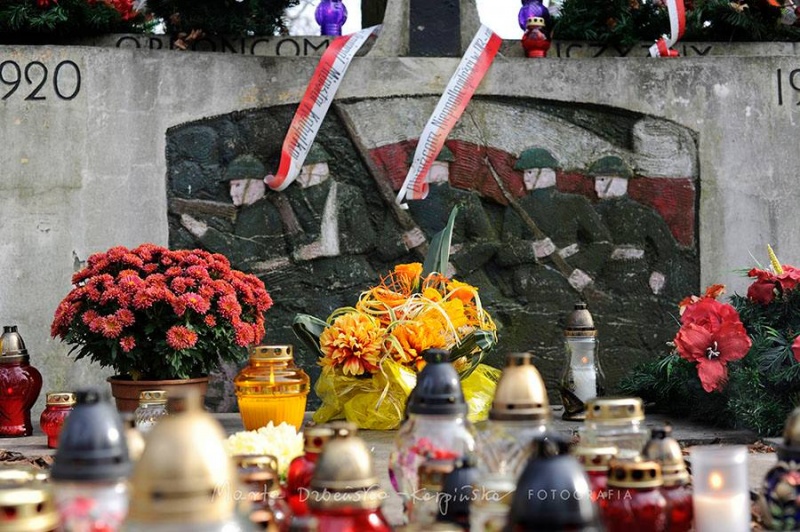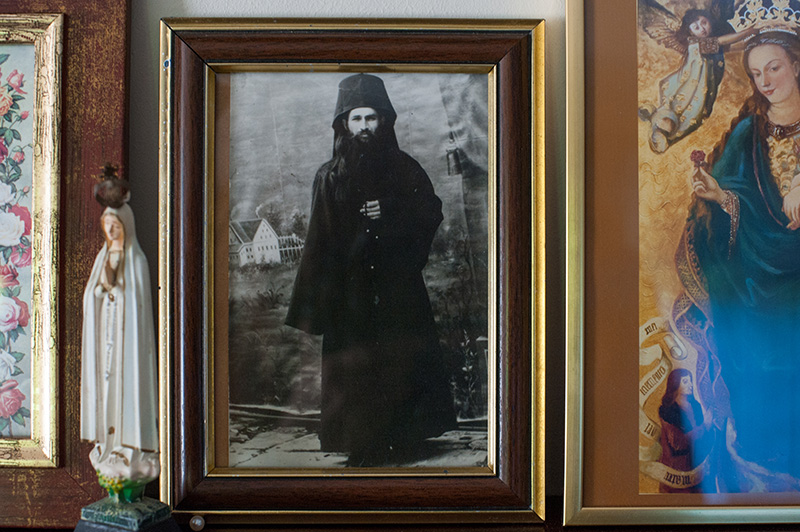.jpg)
Increased traffic in and around cemeteries in Poland and Hungary begins some time before the Solemnity of All Saints. On that particular day, large crowds will besiege both the large and famous as well as the smaller, local necropolises. A week or more before November's feast, cemetery car parks seem to fill up and many people can be seen at the cemeteries themselves. Before the big day, Poles and Hungarians go out of their way to tidy up the graves of those who have passed away. 1 November – All Saints' Day, Mindenszentek in Hungarian, when relatives and friends come, they will be clean and adorned with flowers. Visitors will light candles, talk about a granddad or auntie laid to rest, and if they feel so inclined, a prayer will be said for the soul of the departed. So that they as well as our family, social and national identity are remembered. To cultivate love, trust and hope of coming together in a different world.

KNOWN AND UNKNOWN
The custom to visit greaves of not only relatives but also those of famous people and those of significance for the history, scientific achievements, art and culture of a nation is still alive today. And thus a large number of Budapest residents come to the cemetery by Fiumei (formerly Kerepesi) street, established in mid-19th century, which has become the most prestigious burial site in Hungary. Here one can find graves of well-known Hungarians such as poet Endre Ady de Diósad, writer and parliamentarian Mór Jókai de Ásva, national hero and leader of the 1848 Hungarian Revolution Lajos Batthyány or writer and Noble Prize laureate Imre Kertész. And there is no shortage of Polish accents at this prominent necropolis. Duke Mieczysław Korybut Woroniecki is amongst those laid to rest here – participant of the Hungarian Spring of Nations, a cavalry colonel at a Polish unit between 1848 and 49. The Fiumei cemetery stands testament to more than one hundred and seventy years of Hungarian history, where Art Nouveau tombstones and grand mausolea, designed by the most prominent artists constitute history in themselves.
On the other hand Warsaw residents visit Powązki cemeteries in great numbers – the beautiful, historic Old Powązki, established in the late 18th century, where many distinguished and acclaimed Poles including national activists and soldiers who took part in independence uprisings have been laid to rest, as well as Powązki Military Cemetery established in 1912 where soldiers killed in both world wars lie side by side with 1920 defenders of Warsaw, Warsaw insurgents as well as civilians killed during the uprising. It is also the final resting place for builders of the communist new order buried along the old alley of the distinguished, as well as those murdered by the Security Service which answered the former. It is here that the victims of the 2010 Smolensk air disaster are buried as well as illustrious individuals for Polish culture, science and history such as sculptor Magdalena Abakanowicz, Antarctic explorer Henryk Arctowski, actor Jan Machulski, athlete Kamila Skolimowska, footballer Kazimierz Deyna, Alina and Czesław Centkiewicz – reporters and writes, bard Jacek Kaczmarski and Marian Falski whose ABC books were used by generations of Poles as well as many others. On November 1st candles will be lit on the graves of both those famous and esteemed as well as on old, forgotten tombstones.

WHEN THE GRAVES OF RELATIVES ARE FAR
For Timea Balajcza, a Hungarian from Budapest, who, since getting married to a Pole – Robert - has been living and running a linguistic services company in Warsaw, visiting the graves of relatives on 1st November is often not viable as work and family obligations mean that such an escapade is out of the question. However, that does not mean that she has forgotten those who passed away. She usually visits Hungary at an earlier date and together with family members they visit cemeteries and light candles on the graves of relatives. When visiting Hungarian cemeteries, Timea also likes to stop by gardens of remembrance, where evermore often people scatter the ashes of their deceased relatives. These are beautifully arranged spaces, with flowing water and a place for candles or flowers. In Poland, unlike in Hungary, the law does not permit such a burial method.
Timea has observed that both Poles, who in the most part identify with Catholicism as well as Hungarians, who are a more diverse society in terms of religion with a larger percentage of non-believers, present a similar attitude to remembering those who passed away – caring for tombstones and making efforts to cultivate their memories within the family. She herself tells her three daughters about their Hungarian ancestors, who are no longer in the world of the living, hoping to instil awareness of their roots and family heritage in her offspring.
Angelika Korszyńska-Górny, a Hungarian from Carpathian Ruthenia will not visit the graves of her relatives on November 1st either. As these are in Uzhhorod, seven hours by car from Warsaw where she lives with her husband Grzegorz and five of their children. Grzegorz is from Wrocław, his relatives are also buried far away from the capital and so on All Saints' Day and All Souls' Day, the family visits the grave of fr. Popiełuszko by St. Stanislaus Kostka church and then go to Powązki Cemetery. They also light candles and lay flowers on graves which no one visits anymore. Remembering their deceased relatives, they pray for those laid to rest there.
For most of us visiting the graves of our relatives on November 1st is unquestionable, and the faithful also make efforts to go to cemeteries on November 2nd. Angelica's experience shows that such festivals are a privilege of free peoples: "All religious practices, including visiting graves, were forbidden in Soviet Ukraine. That was a very difficult period and I grew up during such times. When churches were opened in 1991 and religious cult was permitted, many people did not even know what the forbidden customs were as they were only remembered by old ladies. Awareness changes slowly, akin to groping around in the dark. However I do remember that on 1 November 1991, like never before, at a cemetery near my home lots of people appeared with flowers and candles. I walked along with them, moved to the core."
Angelica's parents made sure that their three daughters knew the family history. Today that knowledge is passed down to the next generation, as even though graves may be far away, the family and its history should be close to the heart and remain alive in their memory: "My ancestors were individuals actively participating in the lives of local communities. My mother's great-grandfather was a town mayor. As far as I know there were two priests in the Korszyński family and Eastern Orthodox monks on my grandmother's side of the family. One of these – father Basil (Vasyl) – walked all the way from Carpathian Ruthenia to Athos Peninsula twice. On the second occasion he remained there. They were beautiful people and I feel a strong connection with them."
Monk Basil is particularly close to Angelica's heart. She has his photograph and harbours a belief that he is looking over her family. "He was a very emotional person. People said that he will either become a saint or end up in prison. When he arrived to Athos for the second time, the family lost contact with him. We tried to find out what happened to him and found out that he became entangled in a dispute with his superior – a very difficult man – and manhandled him somewhat. Basil was so distraught at not being able to contain himself, that he adorned a repentance sackcloth and set off never to be seen again. I pray for him often and ask him to pray for one of our suns who is also hot-blooded."

POLISH GRAVES IN BUDAPEST
Most current parishioners of the Holy Mary Helper of the Faithful parish in Budapest go to Poland for All Saints' Day. Only a few remain in Hungary's capital, many of whom had been associated with this city for generations and whose ancestors have been laid to rest at the Rákoskeresztúr cemetery in District X. They are the descendants of 19th century economic immigrants, who subsequently brought poor Galicia residents to the budding Budapest hungry for labourers – primarily in quarries, clay excavation, brick making and construction. "At the turn of the nineteenth century a few thousand Poles lived in the colony. In early 20th century they already had their own priest from Lviv – Wincenty Danek, who organised their religious, social and cultural lives. An idea was coined to erect a church, however it was only acted upon after World War I. The church, built using money from collections held amongst Poles, was consecrated in 1926." – says fr. Krzysztof Grzelak (SChr) who has been running the Polish parish in Hungary's capital for the last five years. The torments of war in the 1940s and post-war re-shuffles resulted in most Poles leaving with only a few staying behind in Budapest. A few years down the line a new wave of immigrants joined them – those who arrived here between the 1960s and 80s within the scope of student exchanges as well as Polish women who married Hungarians. Fr. Krzysztof refers to this wave as "romantic immigration". Today these people make-up the bulk of his parish.
.jpg)
Every year on 1 November the parish community gathers to celebrate Holy Mass at the Rákoskeresztúr cemetery. There is a plot here where more than 100 Polish soldiers who were killed or died during World War II are buried. Other Poles, the lions; share of whom passed away during the Second World War are buried in the vicinity. All in all there are approximately one hundred and forty Polish graves here. "Between seventy and ninety people come to mass and these include Polish embassy representatives and the Ambassador. It is now traditional for us to gather here and remember our relatives who have passed away, soldiers who had died and those who lived in Hungary and have been laid to rest here." - says fr. Krzysztof Grzelak. Then he adds: "Our relatives who have passed away and we need prayer. For many that need is as clear as day, regardless of how strong or aware they are in their faith. One cannot limit oneself to simply yearning for those who have passed away."
"Eternal rest grant unto them, O Lord,
and let perpetual light shine upon them.
May they rest in peace. Amen
tekst i zdjęcia:
Marta Dzbeńska Karpińska
politolog i fotograf, redaktorka portalu wrodzinie.pl
